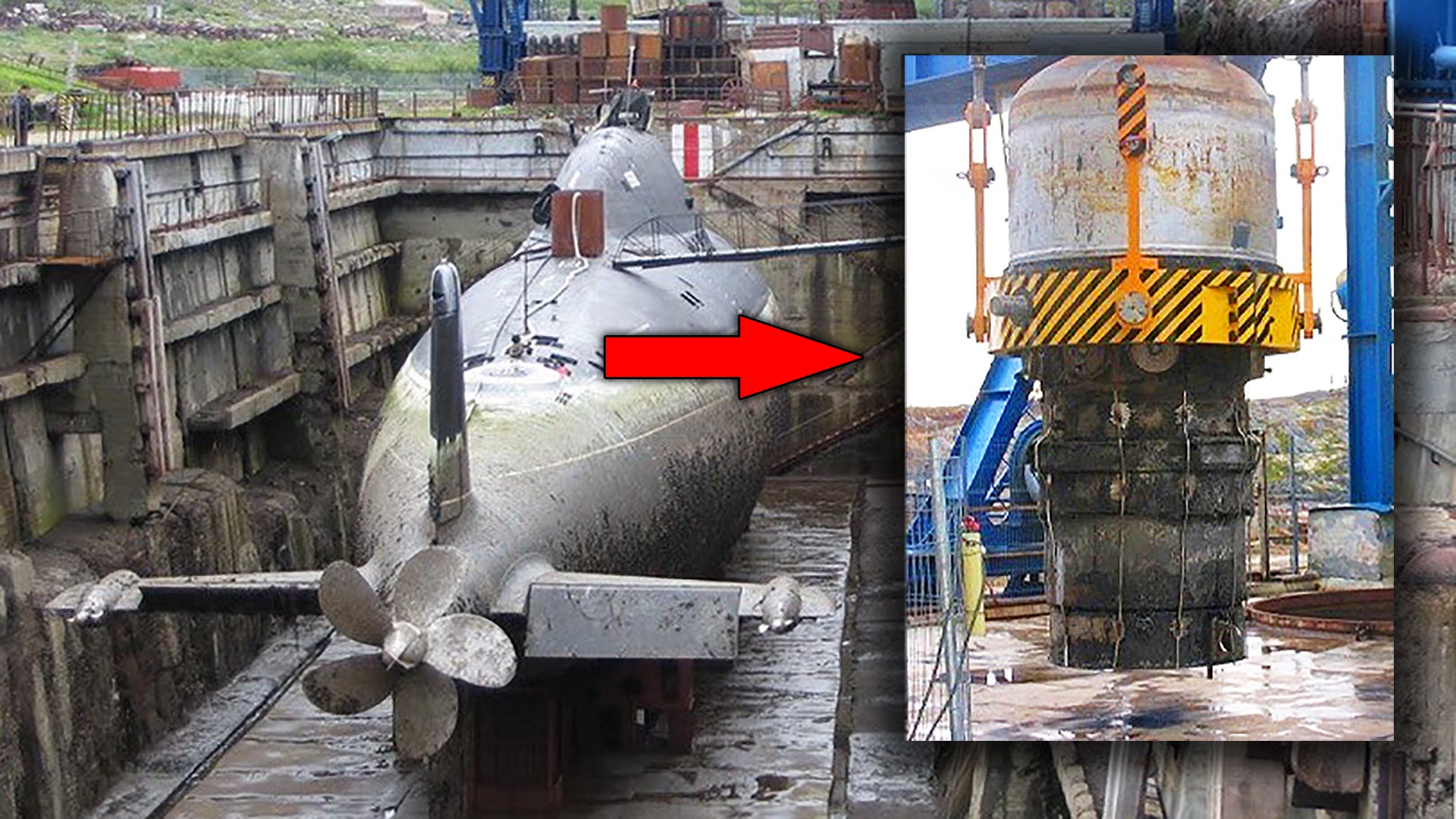When it comes to nuclear fast attack submarines (SSNs), it doesn’t get more hot-rod than the Soviet Alfa class. With a hull built of titanium, a highly automated control system run by a skeleton crew, and a reactor that was cooled by molten lead-bismuth, the Alfa class was absolutely cutting-edge when it debuted in the early 1970s. Able to hit speeds in excess of 40 knots while submerged, the Alfas were rocketships of the undersea world, with only the one-off K-222 “Golden Fish” submarine eclipsing their speed capabilities. They were also remarkably small, partially due to their reactor design, which had many advantages, but if its molten metal coolant stopped circulating, it turned into a mummified brick. Now, pictures from the removal of one of these reactors from a decommissioned Alfa class boat give us an idea of just how compact the class’s exotic reactors really were.
Before you continue on, you can read and should read all about this marvel of a submarine in this past feature of mine. It’s essential to get a better understanding of just how remarkable these submarines were when they first emerged and the many tradeoffs in their design that truncated their fleet size to just seven boats.


@Captain_Navy, a must-follow on twitter if you are into naval warfare, posted the shot below this weekend. They are from the 2005 de-fueling of the Alfa class submarine K-123, which was decommissioned in 1996. They are some of the best shots of an Alfa class of all time, which is known as something of a looker in submarine aficionado circles. K-123 was put into service in 1977 after a construction period lasting a decade.








Another great Twitter follow, @Saturnax1, added a couple of shots of the submarine’s BM-40A reactor. This compact unit put out a whopping 155 megawatts, which equated to 40,000 shaft horsepower driving the submarine’s propeller. That’s a ton of juice for a sub that displaced just 3,200 tons submerged. In comparison, the nuclear fast attack submarine that proceeded it, the Victor class, displaced more than twice as much tonnage, but ran on a far larger pressurized water reactor.


The compact liquid metal cooled reactors on these boats were amazing in many ways, but proved problematic. Just five years into its service life, K-123 suffered a major reactor failure. Globalsecurity.org describes the major tradeoffs in regards to the reactor design and the Alfa class’s capabilities as such:
Project 705 and 705K submarines had record high underwater speed (more than 40 knots) and maneuverability, they successfully completed several long autonomous trips. It took them about 1 minute to accelerate to full speed, and it took 42 seconds to circulate with a 180° turn. For speed, the submarine of project 705 was even listed in the Guinness Book of Records.
At the same time, even with good PPU, the operation of the boats of projects 705 and 705K with LMT had certain difficulties, such as the difficulty of eliminating malfunctions due to the tightness of the reactor compartment, the need for an external energy source when being at the base with the reactor shut off, the need for regular regeneration of the coolant … for these problems in the early 90s, when the submarine fleet began to decline, they began to be decommissioned. The K-705 submarines were decommissioned in 1990, and the 705K submarines in 1996.
The commanders and officers of submarines with reactor facilities developed at the IPPE gave a very high rating to the submarine itself and its nuclear power plant, calling it a “miracle boat” that was far ahead of its time.
Today it can be considered universally recognized that in the IPPE under the direction of A.I. Leypunsky laid the foundations for a new direction in nuclear energy, and a unique reactor technology was demonstrated on an industrial scale. This made it possible to ensure the compactness of the reactor installation, which is important when creating submarines of limited displacement, to ensure high maneuverability, and to increase the reliability and safety of the reactor installation.
…
With the withdrawal of the last submarine from the Navy from the Navy, a certain stage in the development of ship nuclear energy was completed. The use of liquid metal coolant reactors in nuclear submarines has two opposing views. Some, and most of them, considered this a mistake due to the accident rate and low reliability of the equipment. Others pointed to the high combat qualities of the nuclear submarines: project 705 and 705K boats could successfully evade enemy torpedoes precisely at the expense of speed and maneuverability, short time to bring the reactor out of a subcritical state into energy mode, and ease of control.
…
In April 1982, during a cruise of the K-123 nuclear submarine, a PPU accident occurred – due to improper crew actions, the alloy was thrown into the compartment through the impulse pipe of the gas system. PPU had to be taken out of action and “frozen”. The subsequent revision of the PUF also revealed irreparable great corrosion damage to the steam generator pipe systems from the side of the secondary circuit, which required a complete replacement of the PPU compartment (there was a replacement BM-40A installation kit).

Although very fast, the Alfa class was far from being considered the quietest attack submarine in the ocean when running at flank speed. Some who faced it in the 1980s noted that at full charge you could hear one farther away than pretty much anything else at the time, but you couldn’t catch it, regardless.
They were truly the aquatic ‘pocket rockets’ of their day—the MiG-25 Foxbats of the underworld.
Once again, for more on these fascinating submarines and their unique propulsion systems, read my previous piece linked here.
Contact the author: Tyler@thedrive.com
